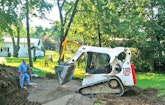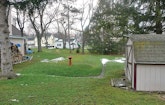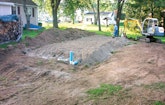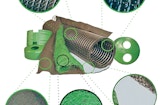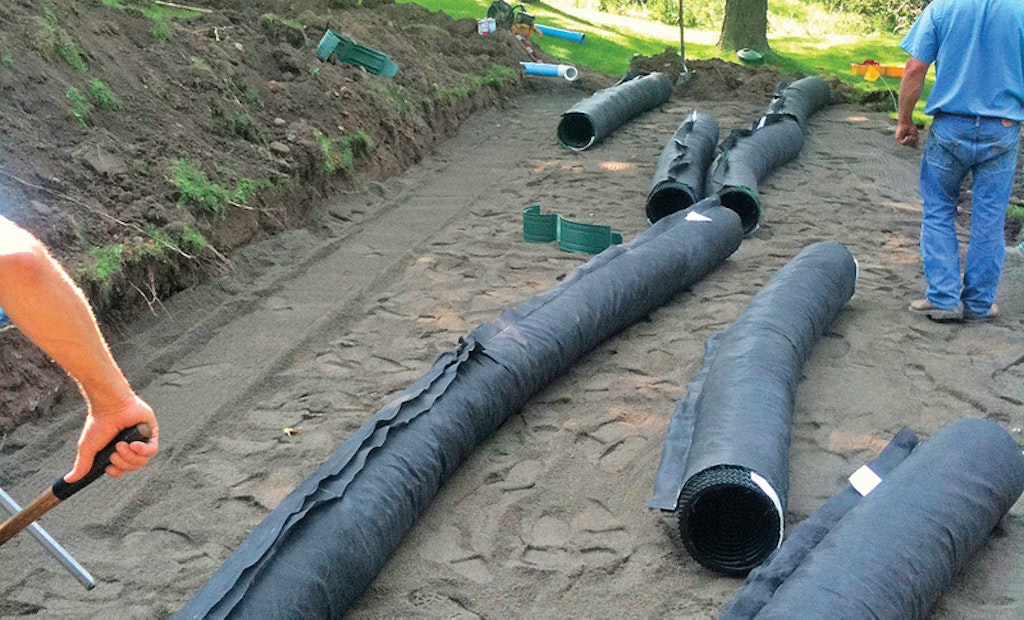Interested in Systems/ATUs?
Get Systems/ATUs articles, news and videos right in your inbox! Sign up now.
Systems/ATUs + Get AlertsThe owner of a four-bedroom home in Rochester, N.Y., noticed some wet spots on his 15- by 10-foot drainfield. As the civil engineer for a township, he understood the implications of leaking leach lines next to a creek. The system was 40 to 50 years old.
The only solution he found on the Internet appeared to be an advanced treatment unit, which was beyond his budget. Looking for a more affordable alternative that did not require a maintenance contract, he found Meyers Environmental in Fairport, N.Y., a company noted for dealing with difficult sites and soils.
Meyers owner Justin DaMore visited the quarter-acre lot and saw only one possible site for a replacement system: a 40- by 70-foot area behind the house. “Property lines and trees limited access and ruled out using large equipment,” he says. “This was a logistics nightmare.”
DaMore had met David Presby, inventor of the Advanced Enviro-Septic (AES) system, and had toured his factory in Whitefield, N.H. DaMore suggested the system, which uses a passive combination treatment and dispersal pipes, and the homeowner agreed to try it. The catch was persuading county regulators to accept the technology.
Barry Zink, Meyers project manager, designed the system with Sean McGuigan of Presby Environmental. The team then created a strategy that classified the system as a pilot project. Its success enabled the technology to expand throughout the state.
Site conditions
Soils are loamy topsoil and silty clay with a percolation rate of 15 minutes per inch. The water table is 18 inches below grade. After the septic tank, the ground slopes in a 3:1 pitch.
System components
Zink and McGuigan designed the system for 600 gpd. Major components are:
- Existing 1,000-gallon concrete septic tank.
- 280 feet of AES treatment pipes from Presby Environmental Inc.
- 60 tons of System Sand.
System operation
Wastewater flows by gravity to the new treatment field. Treatment occurs in perforated plastic pipes with a white Bio-Accelerator geotextile fabric along the bottom exterior surface, and a surrounding layer of green plastic fiber mat and black geotextile fabric (see Figure 1). Ridges in the pipe allow effluent to flow uninterrupted around the circumference and cool the liquid to ground temperature. Skimmer tabs at each perforation retain grease and suspended solids, protecting the outer layers from clogging.
The Bio-Accelerator filters additional solids, speeds up treatment, facilitates quick startups, provides added surface area for bacterial growth, promotes even distribution, and protects outer layers and receiving surfaces from clogging. The mat of coarse green fibers further filters the effluent as it passes into the outer geotextile layer and grows a protected bacterial surface.
The System Sand bed wicks liquid from the geotextile fabric while transferring air to the microorganisms. The technology provides a huge bacterial surface to break down solids, while ample air supply and fluctuating liquid levels increase bacterial efficiency. Third-party testing proved that the system treated effluent to less than 2 mg/l TSS and CBOD and to 218 CFU/100 ml fecal coliform.
Installation
The first challenge was convincing Monroe County regulators to accept the technology. The trust Zink had developed over the years with Jeff Kosmala, P.E., senior public health engineer, and Joseph Friser, P.E., associate public health engineer, helped fast-forward the project.
To introduce the product, DaMore invited regulators, engineers, and installers to a training session where Presby displayed the treatment pipes and explained how they worked. Afterward, Kosmala and Friser granted DaMore permission to install the system as a pilot program provided his company and the homeowner assumed responsibility if it failed. They agreed to do so.
“We had to monitor the system, but not test the effluent,” says DaMore. “AES achieved NSF/ANSI Standard 40 Class 1 Certification and Bureau de Normalisation du Québec Advanced Secondary certification in Canada. That satisfied the regulators.”
The next challenge was finding a source for sand that met the exact specifications and sieve sizes of System Sand. “The sand is the system’s lungs,” says DaMore. “It provides a controlled intake of oxygen and a mechanism for releasing gases. Even when the systems are vented, like this one, the correct System Sand is still important, since oxygen also flows through the ground and into the pipes.”
ASTM C-33 concrete sand with no more than 2 percent passing a number 200 sieve, meets System Sand specifications.
The third challenge was logistics. Zink took measurements, staked out the 42- by 12-foot treatment site, and plotted how to transport the sand to the rear of the system. “I worked out how to maneuver the tracked mini-excavator to reach the sand and deposit it in the middle of the bed,” he says.
On the first day, his four-member crew created a driveway made of 6-foot plastic-injected molded mats (AlturnaMATS) for the dump trucks and machinery. They scarified 6 inches of the treatment site using the excavator bucket, then replaced the septic tank’s outlet baffle, as the tank was otherwise in good condition.
“We didn’t retrofit an effluent filter because the treatment system removes solids so efficiently that a filter is an unnecessary expense,” says DaMore. “Furthermore, as the filter collected solids, it would restrict the flow of oxygen through the system between the high vent on the house and the low vent in the treatment site.” The crew abandoned the original drainfield.
Trucks delivered the dry System Sand the next morning. To achieve the required 24-inch separation from the groundwater, the crew added 6 inches of sand to the treatment site. They then backfilled with sand to extend the bed 12 feet, sloping the toe at a 3:1 pitch. “This eliminated a constructed mound in the backyard, and created a larger playground for the homeowner’s youngsters,” says DaMore.
The Bobcat skid-steer deposited the sand on the edge of the treatment site while the excavator arm spread it around. “I had two guys raking the surface and shooting grades,” says DaMore. “It’s critical that the rows are level.”
Coupler fittings with a tab and slot joined the 10-foot sticks of piping. “Everything snaps together very easily,” says DaMore. To hold the seven 40-foot-long rows of pipe on 18-inch centers, workers staked them, then dumped buckets of System Sand across the lines at intervals. Workers used a laser level to set the rows, as variations beyond one-half inch could affect system performance.
The men mounted the lower vent pipe on the last row, then added sand until it was level with the crowns of the pipes. To camouflage the vent, DaMore installed a 4-inch Dirty Bird birdbath (BS Design Corp.).
The next day, the crew topped the bed with 6 inches of System Sand, then added topsoil and seeded it. Meanwhile, trucks delivered corrugated pipe and 100 cubic yards of No. 2 stone for curtain drains at the bottom of the slope and along the right side of the treatment site. Installing the drains the required 10 feet from the system left little space between them and the property line, so workers had to move the stone in wheelbarrows.
That fall, the system was unaffected by heavy rains, and the backyard was drier than the homeowner had ever seen it. According to DaMore, the AES system saved the man at least $10,000 when compared with the cost of an aerobic treatment unit.
Maintenance
Maintenance consists of pumping the septic tank every two years.

